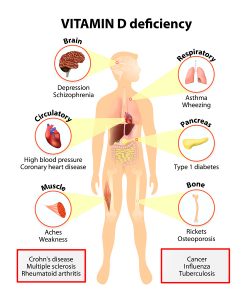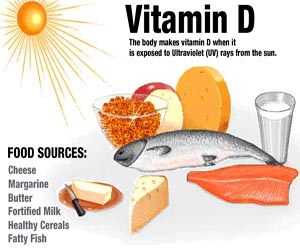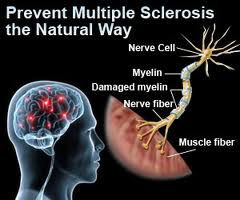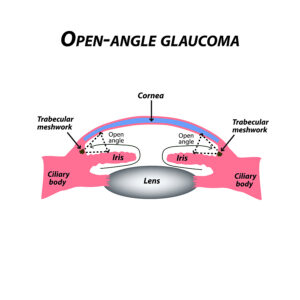The Covid-19 coronavirus crisis is teaching us that an adequate vitamin D level strengthens the immune system.
When we age, our resistance to infections weakens, but this may be because our immune system needs more vitamin D3. I have reviewed the super powers of vitamin D3 before in 2014. In the past the thought was that the human body would need only 400 IU of vitamin D3 every day to cure rickets. And these were the daily vitamin D3 recommendations from medical authorities for several decades. Gradually it became known that for cancer prevention, infection prevention, cardiovascular illness prevention and for diabetes prevention much higher doses of vitamin D3 were necessary. As pointed out in the previous link, almost 50% of the world population is deficient in vitamin D. This is due to a lack of exposure to sunlight and due to inadequate supplementation with vitamin D3.
History of vitamin D
Dr. Adolf Windaus received the Nobel prize for chemistry in 1928. It was to acknowledge “… his studies on the constitution of the sterols and their connection with vitamins”. His work involved the metabolism of vitamin D and the precursors of vitamin D.
Rickets
As the above link shows, rachitic children were treated since the mid 1800’s with cod liver oil and since the early 1900’s also with ultraviolet light. But we know now that 400 IU of vitamin D3 per day is just enough to cure rachitic children, but it is not enough to strengthen the immune system to fight influenza viruses or the Covid-19 coronavirus. I will discuss further below what vitamin D blood levels are important to achieve a healthy state of the immune system.
Adequate vitamin D level strengthens the immune system
The immune system is very complicated and consists of many cell types that interact with each other and the rest of the body. It is important to recognize that the innate immune system immediately inactivates intruding viruses. But the vitamin D blood concentration has to be high enough. The acquired immunity consists of antibodies that are produced by B cells. The antibodies were produced during prior infections that you have survived and you are now immune to. However, other antibodies that circulate in your blood may have originated from vaccines you received in the past (whooping cough, measles, tetanus, diphtheria etc.). With the Covid-19 coronavirus it is the innate immunity that plays the biggest role until a vaccine will be found in the future.
Vitamin D is a hormone
This 2013 paper explains that vitamin D is a hormone that stimulates its own vitamin D receptor. This is a nuclear receptor that has close relations to the cell DNA and can stimulate more than 900 polypeptides. They are messenger molecules that are involved in a variety of physiological functions. One of the key functions is the immune system. This link explains that T cells that have vitamin D receptors can develop into cytotoxic T cells (also known as “killer T cells”). They are important in fighting cancer, but also parasites.
The key is that the hormone vitamin D can release more than 100 polypeptides that have the power to fight virus attacks including the Covid-19 coronavirus.
Three mechanisms how vitamin D works against the virus
The researchers outlined 3 mechanisms of how vitamin D works:
- Maintaining tight epithelial junctions making it more difficult for the Covid-19 coronavirus to penetrate.
- “Killing enveloped viruses through induction of cathelicidin and defensins.” These powerful antiviral polypeptides can kill viruses that have invaded the blood stream within 1 to 2 days.
- “…And reducing production of proinflammatory cytokines by the innate immune system, thereby reducing the risk of a cytokine storm leading to pneumonia.” It is people who get the viral pneumonia that are at a high risk of death. By bringing the blood level up to the higher range of normal, between 50 and 80 ng/mL, patients that have encountered Covid-19 coronavirus are more likely to survive.
Two polypeptides, cathelicidin and defensins
Again, I like to emphasize that it is not vitamin D that has a direct effect on the virus. It is two polypeptides, cathelicidin and defensins, which are powerful antiviral polypeptides, that are released by vitamin D.
They can kill viruses that have invaded the blood stream and can eliminate the cytokine storm. This all happens very fast, within only 1 to 2 days. But you have to have an adequate vitamin blood level for this to occur (about 50-80 ng/mL).
Sources of vitamin D
First of all, vitamin D is readily absorbed from food. But there are not many foods that contain enough vitamin D for the immune system. The ones that contain vitamin D are as follows:
- “Fatty fish, like tuna, mackerel, and salmon.
- Foods fortified with vitamin D, like some dairy products, orange juice, soy milk, and cereals.
- Beef liver.
- Cheese
- Egg yolks. “
Sun induced amount of vitamin D
Secondly, vitamin D can be synthesized in the skin from exposure to sunlight. But for this to happen all the necessary enzymes need to be present. This link explains that many older people above the age of 65 have low vitamin D blood levels because of a lack of sun exposure and a lack of cutaneous synthesis because of enzyme issues.
Vitamin D supplements
The most reliable source of vitamin D are vitamin D3 supplements. When people supplement with the same dose of vitamin D3 there will be people who get higher vitamin D blood levels than others, as absorption in the gut is different for different people. The ones who have relatively low vitamin D blood levels are often called “slow vitamin D absorbers”. But when the vitamin D3 dosage is increased even those people will reach the recommended high normal range (50-80 ng/mL).
Vitamin D blood level
The vitamin D blood test has the scientific name “25-hydroxy vitamin D level”. This is now the recognized gold standard for determining who is deficient or has normal levels with respect to vitamin D. The following 2013 publication has studied the vitamin D level of 1,470 healthy Swiss men and women, 60 years or older. Vitamin D levels were classified as severely deficient when the level was below 10 ng/mL. The vitamin D level was deficient between 10 and 20 ng/mL. The level was insufficient when between 21 and 29 ng/mL. A level above 30 ng/mL is normal.
8 % of the subjects were severely insufficient and 66% had insufficient vitamin D levels. Only 26.1% of the subjects had normal levels. Over 50% of healthy older Swiss (above the age of 70) had insufficient vitamin D levels.
Which vitamin D level is safe and which is not?
A peer-reviewed publication of the effects of vitamin D in health and disease contains 269 references.
What vitamin D level is optimal? This question was reviewed in this paper.
- Below 15 ng/mL the immune system is paralyzed
- With a level above 30 ng/mL the immune system is working
- A level of 50-80 ng/mL has the immune system working optimally
- Above 150 ng/mL toxic vitamin D levels start
- With 300 ng/mL severe toxicity begins
Vitamin D toxicity
It is only with high levels of vitamin D (more than 150 ng/mL) that you have to worry about high calcium levels in the blood or kidney stones (toxic levels). But the key is to not exceed 80 ng/mL regarding the vitamin D blood level. This gives you a lot of flexibility before you reach toxic levels (above 150 ng/mL). For those who want more information, here is a thorough, peer reviewed publication about vitamin D toxicity with 59 references.
Vitamin D supplement compliance
The question is why not more people take adequate vitamin D3 supplements. We know that vitamin D can prevent so many chronic diseases including serious viral infections. The answer is complex, but it includes a fear of the population of vitamin toxicity (kidney stone and high calcium levels). However, as pointed out before, this occurs only above a vitamin D level of 150 ng/mL. With proper vitamin D blood level monitoring you never reach toxic levels of vitamin D.
Denial
Denial likely is another major factor. People feel that if they have a balanced diet, they would be protected from vitamin D insufficiency. As pointed out before this is a grave error to think as our food does not contain sufficient vitamin D to strengthen our immune system.
False security with low doses of vitamin D
Finally, there are people who think that low doses of vitamin D, like 1000 IU of vitamin D daily, would be enough. But it is not enough. This is why testing vitamin D blood levels is so important. It is a reality check. The blood level must be in the high normal range (50-80 ng/mL). At this level the immune system functions optimally.
Compliance issues
In this context there was an interesting study done by LifeExtension, a company that publishes monthly health magazines. In this study the company examined the vitamin D blood levels of LifeExtension members. They are the ones who should be knowledgeable in how important it is to have good, preventative vitamin D blood levels. The study showed that 38% of the vitamin D test results were less than 30 ng/mL. In addition, 69% of the vitamin D tests were less than 40 ng/mL. Finally, 85% of the vitamin D test results were less than 50 ng/mL. What this means is that LifeExtension members were non-compliant when it came to taking regular adequate vitamin D3 doses. This resulted in levels that were too low for the majority to protect them from the Covid-19 coronavirus.
Covid-19 coronavirus infections and vitamin D blood level
There is a tight relationship between vitamin D blood levels and the strength of the immune system. Essentially, coronavirus mortality measures who is vitamin D deficient. Without enough vitamin D on board the virus penetrates into the blood stream and penetrates the lining of the respiratory tract. Next the cytokine storm develops, which leads to viral pneumonia. Higher doses of vitamin D3 will mitigate the course of Covid-19 coronavirus.
Conclusion
The Covid-19 coronavirus pandemic has taught us how important an intact immune system is to survive the virus when you get it. We do know for some time how closely related a good vitamin D level is with the functioning of the immune system. I have reviewed here what a desirable vitamin D level is and how we can achieve this with oral vitamin D3 supplements. The goal is to achieve a vitamin D level in the upper range of normal (50-80 ng/mL). With a level like this the virus cannot penetrate the mucous membranes of the respiratory tract and even if it did, it cannot produce a cytokine storm in the blood that would lead to the deadly viral pneumonia or to blood clots. When the virus invades the bloodstream, vitamin D releases powerful antiviral polypeptides that can kill viruses within 1 to 2 days.
Literature
Here are some peer-reviewed publications on vitamin D:
- https://www.mdpi.com/2072-6643/12/4/988/htm157 references (April 2, 2020 publication)
- The role of Vitamin D in the prevention of Coronavirus Disease 2019 infection and mortality
- Startling Findings About Vitamin D















